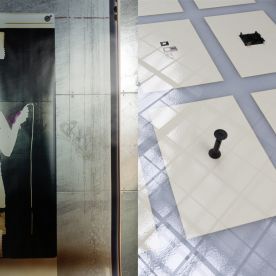| CRK+
is a network of four independent institutions in
Graz whose
common interest lies in the conveyance of contemporary art within an
international context. Openings 6pm <rotor> 7pm Camera Austria 8pm Grazer Kunstverein from 8pm Grazer Kunstverein Summer Party+ Free Shuttlebus Departure Vienna 14.06.2019, 3pm Station Opera, Bus 59a Departure Graz 14.06.2019, 11pm Station in front of Künstlerhaus KM– Burgring 2  CRK+ archive: Spring 2017 Summer 2017 Autumn 2017 Winter 2017 Spring 2018 Summer 2018 Autumn 2018 Winter 2018 Spring 2019 PRIVACY STATEMENT |
This
exhibition brings together two artists living in Vienna who, though in
different ways and from different perspectives, are nevertheless very
comprehensively addressing central aspects of the photographic. In recent years, Mladen Bizumic has been intensely studying the details of Kodak’s company history, for which the first digital camera was developed as well. The company did not pursue that technology, however, and was ultimately forced to file for bankruptcy in 2012. Yet Bizumic is not presenting a nostalgic look back or a romantic swansong. It is rather an analytical and reassembling gaze at the transition from an industrial to a postindustrial age, an age in which production and information are merging, when work and time are becoming fluid, of the informal, of representation becoming fluid as well. What consequences does this produce for our understanding of photographic images? Sophie Thun, in turn, has become known above all for her complex, life-size self-portraits, which she combines with photograms of her body, then photographs herself again with that photograph and shows these layers of self-depiction at wall size in the exhibition space in which these works were usually also created. Where does representation occur, and when? How do the different layers of Thun’s work refer to one another? One can, in any case, no longer speak of being captured by the images but rather of setting a photographic process in motion that finds its point of departure in the experimental disposition of the artist herself. By doing so Sophie Thun also rejects the history of the depiction of the female body that makes it seem like the passive object of an appropriation by (male) representation. Both positions destabilize our certainties about photographic images, how they are made, what we can see in them and why, and what we can know about them. Is Bizumic’s work really primarily about the Kodak company, or is it rather about a (historical—that is, made, produced, and established) paradigm, which is supposed to determine which images we regard as images of our world and the way that they refer to this world? But could one not say exactly the same about Sophie Thun’s works as well? Is it for her about a way of inscribing herself into the medium of photography, or is not rather much more about how we are already caught up in the layers of this form of representation and wander almost inextricably between its surfaces, like ghosts trying to work their way through the layers of images but without reaching that one surface on which we could find ourselves again? |
 Mladen Bizumic / Sophie Thun: Interiors of Photography |
||
.......................................................................  |
..................................................................................................................................................................................................................................... Camera Austria Lendkai 1, 8020 Graz, Austria |
|
| ....................................................................... | ..................................................................................................................................................................................................................................... |